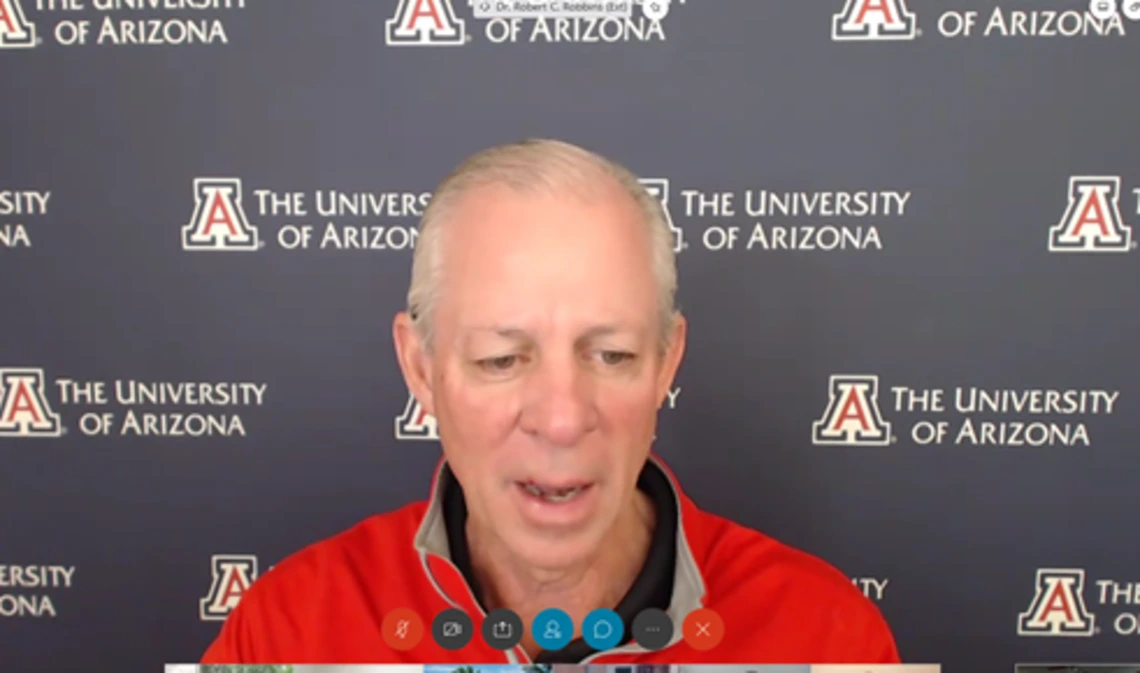NASA Takes Virtual Tour of Mini-Labs for Studying Asteroids
The pandemic on Earth doesn’t stop progress in space as researchers present their work on $3M STEM-engagement project.

University of Arizona President Robert C. Robbins attended NASA's virtual site visit to the ASTEROIDS Laboratory.
As part of an array of space-based research, researchers at the University of Arizona are contributing to a $3 million project that uses mini-laboratories in space to study surface conditions of asteroids. Jekan Thanga, assistant professor of aerospace and mechanical engineering and head of the SpaceTREx Laboratory, is leading the three-year project, which began in 2019 and is funded by NASA’s Institutional Research Opportunity program under MUREP, the NASA Minority University Research and Education Project, or MIRO.
At a virtual NASA site visit on October 13, researchers and students -- including from partner institutions Pima Community College and the University of Puerto Rico -- presented their research progress. Several university leaders praised the team’s resilience and determination.
“I’m extremely excited about what this lab will mean for the university, and especially for our students,” said University of Arizona President Robert C. Robbins. “It’s about the university students and faculty working on the frontiers of space exploration, making new discoveries, inventing new space technologies and paving the way for a future where humanity lives and works in space. Space exploration is for all, and as a Hispanic-Serving Institution, we’re incredibly proud to be making great strides in having underrepresented opportunities be part of these great accomplishments.”
Surpassing Project Milestones
The University of Arizona project lab has been dubbed Asteroid Science, Technology and Exploration Research Organized by Inclusive eDucation Systems, or ASTEROIDS. The central mission of the project is to develop asteroids origins satellites, or AOSATS -- small CubeSat laboratories that operate in low-Earth orbit and contain asteroid material, which came to Earth in the form of meteorites.
The ASTEROIDS administrative program manager is Layne Crawford, and the technical program manager is Stephen Schwartz, postdoctoral researcher in the Lunar and Planetary Laboratory, or LPL. Schwartz is also on the OSIRIS-REx asteroid sample return mission, led by the University of Arizona. Professor Erik Asphaug of LPL is the deputy principal investigator. Co-investigators include Greg Ogden, research associate professor of chemical and environmental engineering; Desiree Cote Figueroa, assistant professor of physics and electronics at the University of Puerto Rico at Humacao; Dennis Just, head of the physics department at Pima Community College; and Kenneth Lawrence from the NASA Jet Propulsion Laboratory.
Even with the challenges of a pandemic, the group has far surpassed project goals. Researchers already have published 10 journal and 36 conference papers about the project.
“This is a project we’re really enthusiastic about,” said David W. Hahn, Craig M. Berge Dean of the College of Engineering. “It touches on all aspects we value: advancing our education mission, our research mission and our mission of accessibility. Our students and faculty are hard at work advancing the technology of space exploration, and this project is really key.”
Thanga also highlighted the dozens of partnerships involved in the MIRO project and other university space programs -- between departments and colleges across campus, and academic, governmental and commercial institutions. For example, Space TREx was one of the only university units invited to present at EngageSpace, hosted by AFWERX, the innovation arm of the U.S. Air Force. Space TREx showcased its AI solution for on-orbit spacecraft maintenance and repair.
On campus, students and researchers collaborate with the Applied Research Corporation and Tech Launch Arizona, the university’s commercialization arm. Jekan and his team have disclosed nine new inventions in the last 18 months.
“Our students always light up when they have an invention to disclose,” he said.
Setting Up Students for Success
During the site visit, ASTEROID team members provided a brief overview of how they’re supporting students, and in particular how they’ve adjusted instruction due to COVID-19. For example, Cotto-Figueroa explained how she uses cross-sections of popular candy bars to describe asteroid material. Instead of doing a hands-on experiment as a final for one of his undergraduate classes, Thanga tasked his students with designing roller coasters.
A cohort of 41 students -- 32.4% of whom were Latino or Hispanic and 41% of whom were women – participated in a summer academy as part of the ASTEROIDS Lab’s Undergraduate Research and Education Program. They received a crash course in concepts like planetary science and space propulsion, as well as mentorship from faculty and graduate students. As a final project, student teams designed lunar mission concepts. One group of 16 students wrote a paper that was accepted to the Earth and Space Conference 2021, and 30 of the students are continuing their research into the fall semester.
“Through research, these students will have a newfound appreciation of the marvelous world around them, and become really responsible citizens,” said Elliot Cheu, interim dean of the College of Science. “It will also help them to further their careers as scientists and engineers. And we believe that will help them to become ever more inspired, curious and ambitious.”
MIRO representatives attending the presentation concluded the day with a virtual tour of the university’s facilities and a commendation of the university’s space programs.
“It’s obvious that the University of Arizona has really put a lot of effort into sharing your progress and the great work being done at your university,” said Rebecca Flick, MIRO Specialist at NASA Armstrong Flight Research Center. “So, from the MIRO team, we appreciate all of your time and hard work.”

